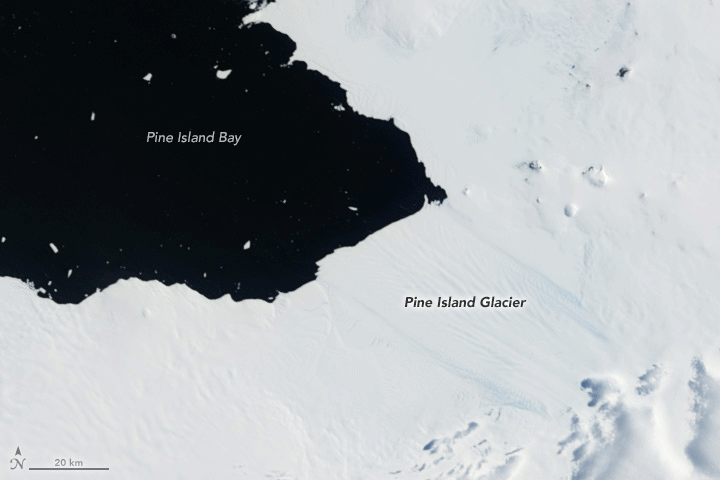Environment & Energy
Related: About this forumNASA Satellite Spots Mile-Long Iceberg Breaking Off of Antarctic Glacier
NASA Satellite Spots Mile-Long Iceberg Breaking Off of Antarctic Glacier
By Kacey Deamer, Staff Writer | February 16, 2017 03:54pm ET
 ?interpolation=lanczos-none&downsize=*:1400
?interpolation=lanczos-none&downsize=*:1400
Antarctica lost another block of ice when the Pine Island Glacier shed a 0.6 to 1.2-mile (1 to 2-kilometer) iceberg on Jan. 26.
Credit: Jesse Allen/ NASA Earth Observatory
A massive, 1-mile-long (1.6 kilometers) chunk of ice has broken off Antarctica's fast-changing Pine Island Glacier, and NASA satellites captured the dramatic event as the icy surface cracked and ripped apart.
The Pine Island Glacier is one of the largest glaciers within the West Antarctic Ice Sheet, accounting for about 20 percent of the ice sheet's total ice flow to the ocean, according to NASA scientists. The immense glacier is also one of the least stable, and in recent years, the ice sheet has been quickly retreating and losing massive amounts of ice. Previously, icebergs the size of cities have broken off of the Pine Island Glacier. [Photo Gallery: Antarctica's Pine Island Glacier Cracks]
The glacier's last major iceberg break — an event known as calving — was in July 2015, when an iceberg measuring almost 225 square miles (580 square kilometers) separated from Pine Island Glacier.
The Earth-watching Landsat 8 satellite captured images of the latest iceberg event between Jan. 25 and 29, seeing the progression from the initial crack to the iceberg floating into the bay. Though this latest iceberg is about 10 times smaller than the 2015 event, measuring between 0.6 and 1.2 miles (1 to 2 km), NASA scientists said the recent break shows how fragile the ice shelf is.
More:
http://www.livescience.com/57915-iceberg-breaks-off-antarctica-pine-island-glacier.html?utm_source=notification
longship
(40,416 posts)The Larsen C ice shelf is about to separate from the continent.

OKIsItJustMe
(19,938 posts)but… it’s a good chunk… none-the-less:
https://www.washingtonpost.com/news/energy-environment/wp/2017/01/10/antarctica-is-set-to-lose-an-enormous-piece-of-ice-the-question-is-what-happens-next/

OKIsItJustMe
(19,938 posts)Jade Boyd – January 9, 2017
[font size=4]John Anderson says Pine Island break is more troubling than Larsen C[/font]
[font size=3]Like ice-sheet experts the world over, Rice University oceanographer John Anderson is waiting to see what will become of dramatic rifts that could signal trouble for two Antarctic ice shelves.
Anderson, a veteran of 24 research expeditions to the Antarctic, said the lesser publicized of the two breaks — a crack in the Pine Island ice shelf on the Amundsen Sea — is the more troubling because of its critical location.
…
Because the Pine Island glacier, which stands behind the Pine Island ice shelf, is one of the five-largest ice streams in Antarctica, Anderson said a breakup of the Pine Island ice shelf would have more far-reaching consequences than a Larsen C breakup.
“The Pine Island glacier and its nearby twin, the Thwaites Glacier, are two of the primary outlets for the Western Antarctic Ice Sheet,” Anderson said. “That ice is as much as 2,000 meters thick, but it sits on ground that is below sea level and is therefore believed to be particularly vulnerable to runaway melting, should the seaward ice shelves break apart.”[/font][/font]
